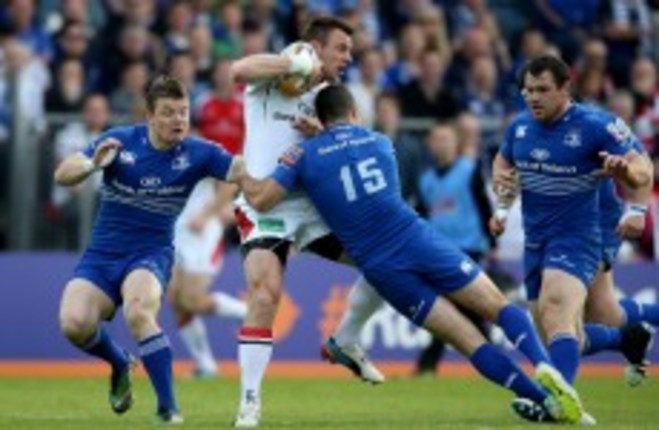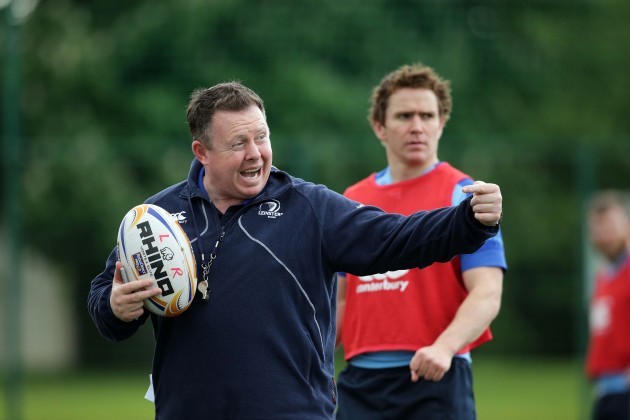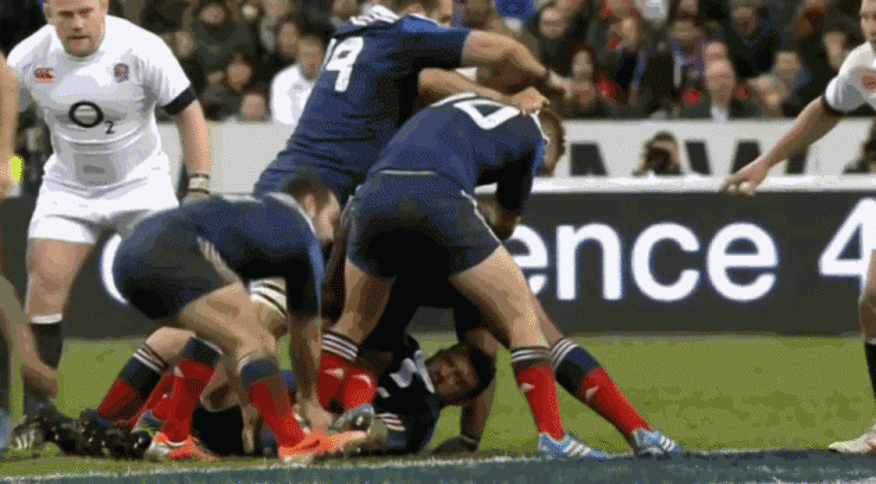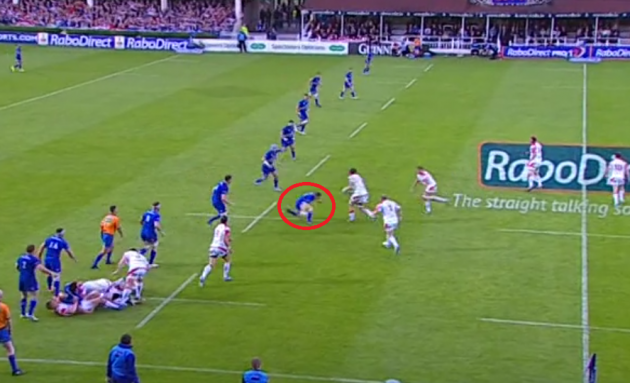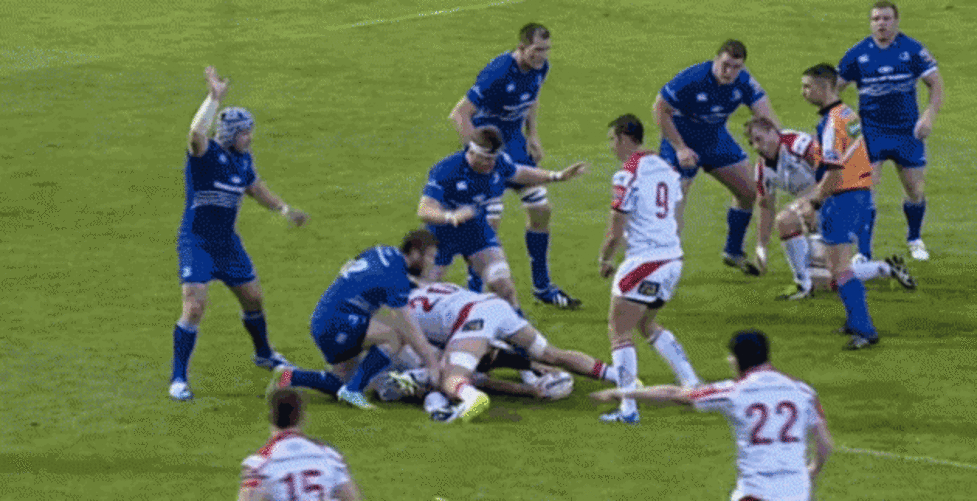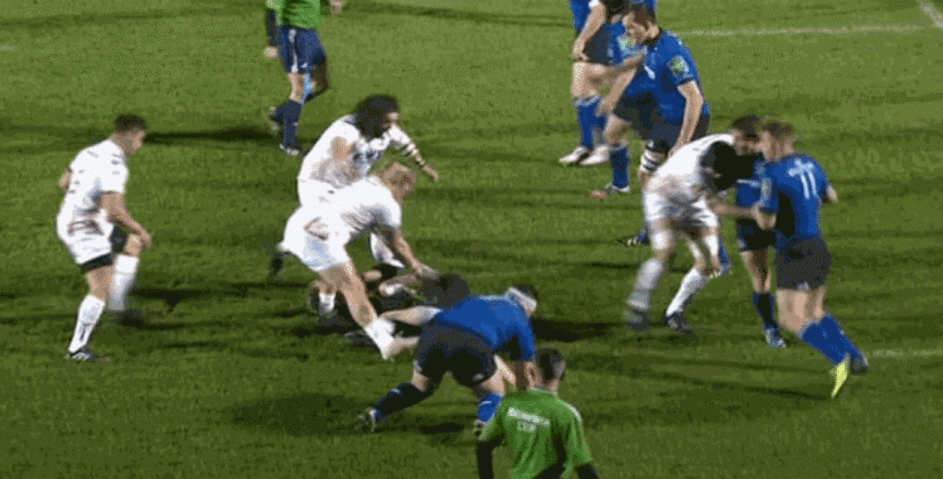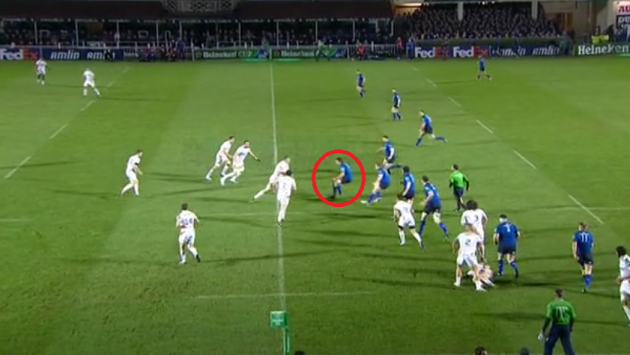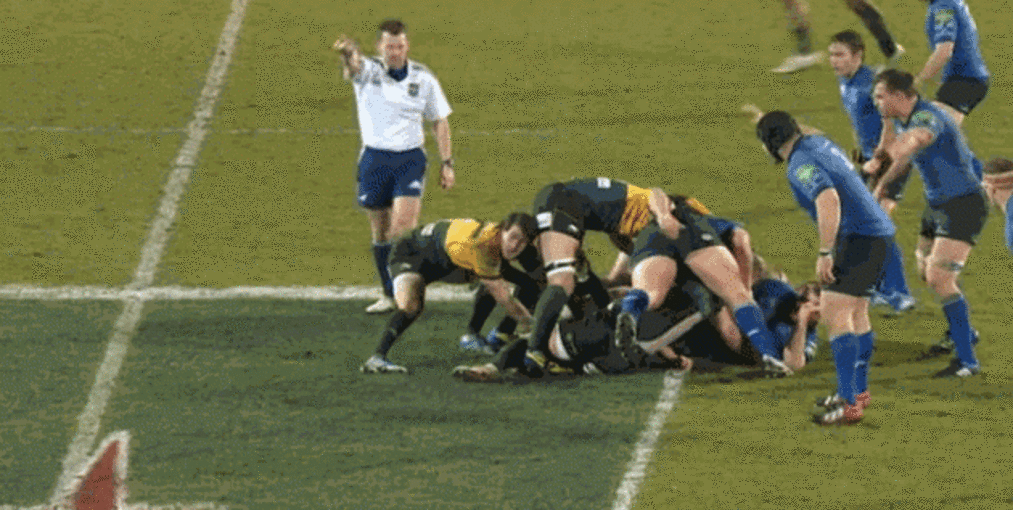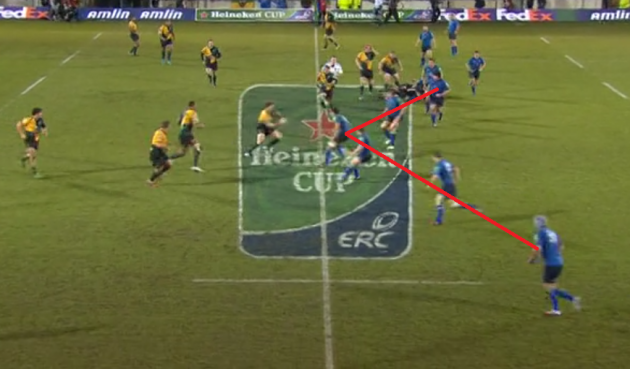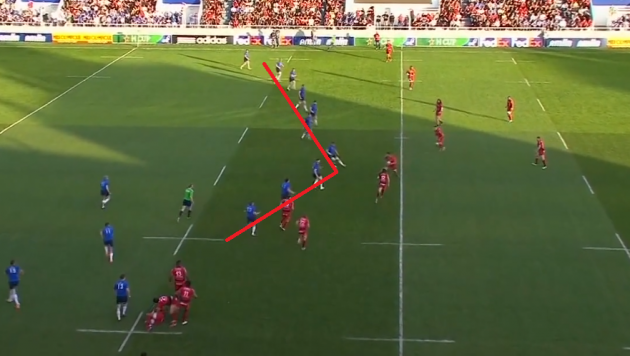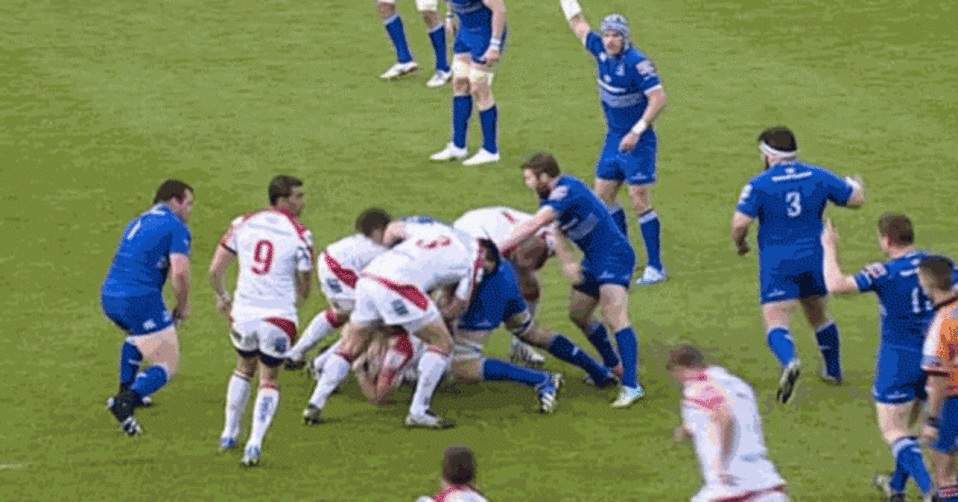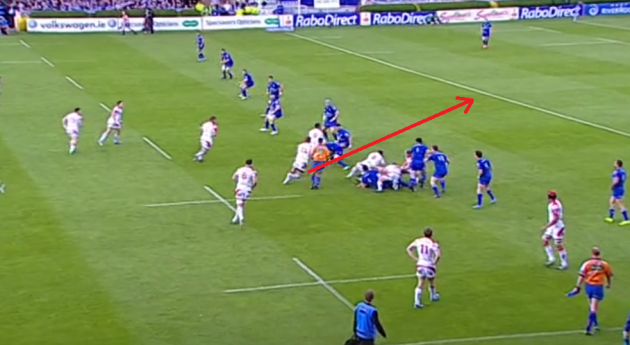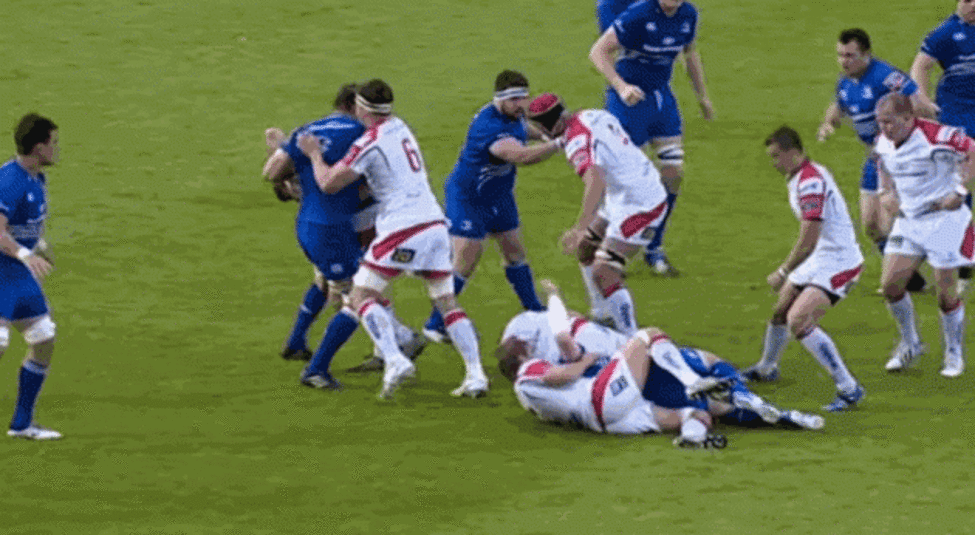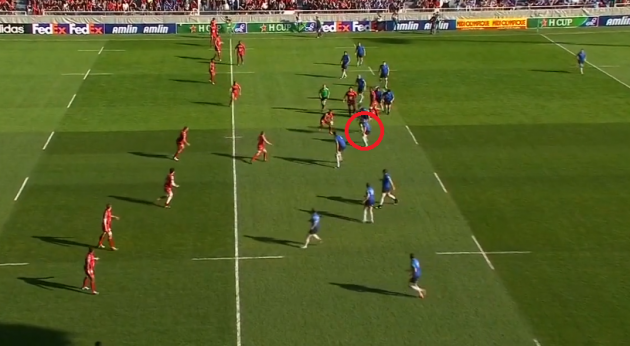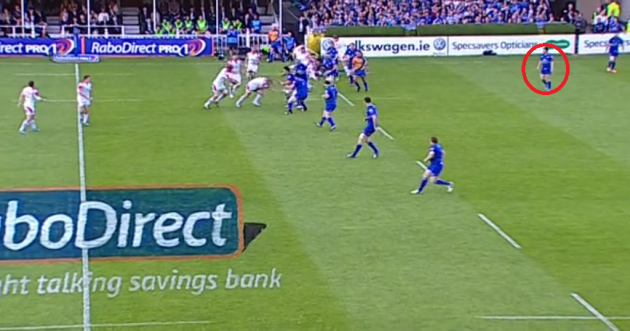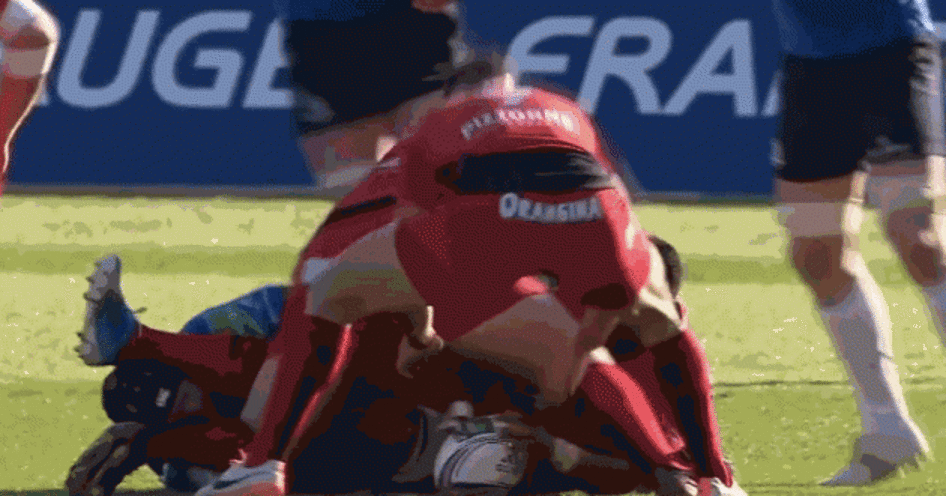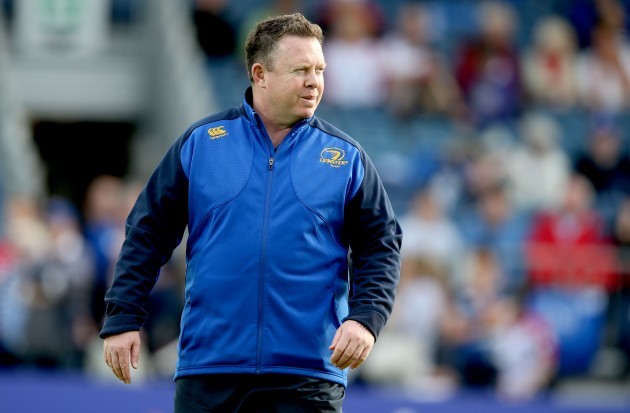DESPITE THE PROVINCE currently preparing for a Pro12 final against Glasgow on Saturday, there is a sense of discontent among a portion of Leinster fans, with many feeling that Matt O’Connor has overseen a decline in performance levels this season.
It has been a strange campaign, underlined by a strong suspicion that the period of dominance Leinster enjoyed under Joe Schmidt, Jonny Sexton and Isa Nacewa is a thing of the past.
It is hard to argue against the idea that the attack has suffered this season, and the loss of Sexton has been key in that regard. However, there have been more positive moves on the defensive side of the coin, with O’Connor making notable changes to Leinster’s system.
Was there any need to change?
One of the major tasks for O’Connor upon joining Leinster last summer was to ‘fix’ the defence, something that had been identified as essential by both the Australian and the players and coaches already at the province.
Last season saw Leinster concede a whopping 59 tries in all competitions, up from 42 in the 2011/12 campaign and 43 in 2010/11. An extra 17 conceded tries from one season to the next is a marked increase, and clearly improvement was needed.
The fact that Leinster still managed to claim a Pro12 and Amlin Challenge Cup double last season indicates just how effective their attacking game was under Schmidt [they scored 92 tries in the 2012/13 campaign.]
“Our defence was poor last year,”admits fullback Rob Kearney. “We soaked too many tries, but because our attack was so strong last season, it kept us ahead of the boat every time.”
The use of the verb ‘soak’ by the Ireland international is key in this regard, and points to the issue that many felt was central to Leinster conceding so many tries last season; a relative lack of line speed.
Modern rugby has become obsessed with aggressive line speed in defence, heavily influenced by the influx of coaches from rugby league. Watching from the outside, O’Connor had a sense of what was missing in Leinster’s sometimes-passive defence.
You need to put pressure on the opposition; you need to make it difficult for them to execute,” says the head coach. “The feeling across the board in Leinster in previous seasons was that they gave too much to the opposition and that made it very difficult to exert that physical pressure.”
The former Brumbies coach felt that Leinster “definitely” had the kind of athletes who would thrive in a system that encouraged greater line speed, testing the players’ decision-making and work-rate. O’Connor rolled up his sleeves and got to work.
A new system of defence
Leinster have not had a dedicated defence coach since the superb Kurt McQuilkin left the province at the end of the 2009/10 season, with Schmidt taking charge of the defence during his time as head coach.
O’Connor did not bring a defensive specialist on board either, again taking those same duties upon himself. Some might suggest that having to focus on defence and attack has seen the latter suffer [and perhaps vice versa in Schmidt's time as head coach], but that is an argument for another time and place.
The Australian head coach has taken charge of coaching the Leinster defence, adding in the line-speed that both he and the senior players felt was necessary.
We get an example in the clip above, in which Leinster burst up off the defensive line and force an error from Toulon a full eight metres behind the gainline. This is exactly what O’Connor means when he refers to making it “difficult for them to execute.”
Using an example from the Heineken Cup quarter-final is perhaps not ideal – as we will come back to later – but the principle is clear. Leinster have looked to burst up in defence more aggressively this season than in years past.
Obviously, it is nigh on impossible to rush on every single phase of defence, but Leinster have looked to be as consistent as possible with their line speed. The example above features Brian O’Driscoll slowing Toulon’s ball at the ruck that precedes Leinster forcing a turnover, and that kind of in-contact competition is key to allowing the line to get set.
In that way, O’Connor’s insistence on line speed has played into the strengths Leinster already possessed around the choke tackle and breakdown. The more the tacklers and assisting players can slow the attacking team’s possession, the more time the defensive line has to arrange itself for the rush.
Decision-making autonomy
Clearly, bringing in a new way of defending takes time and extensive work on the training pitch, and that process is certainly still happening for Leinster. As the season has progressed, we have seen more kinks and wrinkles added to the structure.
O’Connor has placed great faith in his players’ decision-making in defence, allowing individuals the freedom to rush up ahead of the main defensive line. Many teams who operate with high line speed look to either maintain one solid wall of defenders, or get their outside edge up ahead of the rest of the defence.
We see as much in the GIF above, as England get up aggressively in defence, and Mike Brown on the outside left edge is working hard to get up ahead of the defenders inside him. The intention in doing so is to shut off long passing options for France.
Leinster do show a similar pattern at times, particularly when Brian O’Driscoll finds himself on the outside edge of the defensive line, but the Irish province’s rush in defence has become more and more focused on the areas either side of the ruck.
O’Driscoll demonstrates what we’re referring to in the animation above, shooting up ahead of the line at full speed after making a read on Ruan Pienaar’s pass to Iain Henderson.
While the Ulster lock gets his linking pass away, Shane Jennings is in position to hit Chris Henry well behind the gainline, giving Leinster a notable success on this phase. O’Driscoll’s initial line speed is remarkable, and his teammates follow up smartly.
The former [sorry] Ireland centre is not the only player who has the freedom to shoot up out of the line, and it appears that O’Connor has encouraged his players to make reads for themselves and burst up if they feel it’s the right call.
Below, we get an example of substitute Luke McGrath doing so against Ulster. The scrum-half-cum-wing understands that Ulster have limited space in which to attack, reads the pass and shoots up for a positive tackle.
Again, Leinster get a great return as Gordon D’Arcy pounces onto the ball for a turnover, although referee Leighton Hodges is playing advantage to Ulster from earlier in the passage.
Mike McCarthy is one of the players who seems to be enjoying the increased line speed in Leinster’s defence this season, stating that “it’s obviously a good thing.” Below, we see the ex-Connacht lock shooting up ahead of his teammates to stress the Ospreys attack.
As with the previous two examples, McCarthy rushes from a position several defenders out from the preceding ruck. This has become more and more common a trait in the Leinster defence as the season has progressed; coincidence perhaps, or more likely, a sign of the players growing into the system.
As we mentioned before, many other teams who operate with high line speed prefer to get their outside edge ‘up,’ or to maintain a unified, straight wall of defenders. With Leinster, that appears to be less of a priority this season, particularly in the area highlighted in the examples above.
‘Make it difficult for them to execute’
It all comes back to O’Connor’s central notion in introducing additional line speed to the Leinster set-up; forcing the opposition attack to make decisions under increased pressure.
Let’s use the example below to illustrate the point. We can see that McCarthy is the man leading the rush again, in that position three defenders out from the ruck ['pivot' or '30' or whatever each team decides labels it].
While the likes of O’Driscoll and Jennings outside him are working hard to get up off the defensive line too, it’s McCarthy who again spearheads the effort.
George North, at first receiver for Northampton, has options outside him – either a short linking pass to Courtney Lawes, or a pass out the back door to Dom Waldouck – but the Welsh wing feels the pressure and simply tucks the ball and steps back inside…
To where Jamie Heaslip is waiting to smother him and help McCarthy to create another defensive victory for Leinster. By bursting up ahead of his teammates, McCarthy is at the forefront of what is almost a V-shaped defensive line.
In the GIF below, we see something similar, with Heaslip and Cian Healy leading the line up aggressively. The No. 8 and loosehead prop get up ahead of their teammates outside and in doing so, put Toulon’s Konstantine Mikautadze under pressure, forcing him back inside.
On this occasion, like so many others in that European quarter-final, Leinster fail to win the subsequent collision and therefore lose lots of the ground that their initial line speed had eaten up.
The shape of Leinster’s defensive line is very similar to that in the previous example though, showing that ‘V’ again.
At this point, it’s worth stressing that the two defenders on the edges of rucks are rarely in a position to rush up in defence. In those areas, overly-rash decisions will be rapidly punished by an intelligent scrum half.
The ‘pillar’ or ’10′ defender [the player on the very edge of the ruck, usually with his hand in the air] is tasked with filling that hole and covering any late inside passes from the first receiver or a darting scrum-half.
The example below shows Gordon D’Arcy vacating the ‘pillar’ position on the right side of the ruck too early, opening a hole for Tommy Bowe to surge through off Pienaar’s smart inside pass.
The GIF above also allows us to underline the role of that second defender out from the ruck, the ‘post’ or ’20′ or various other names each different team has. Generally, this player is tasked with covering the sniping scrum-half, and we can see that Marty Moore is reacting to Pienaar’s run just before D’Arcy steps out to make the hit.
The point here is to highlight that the two defenders closest to the ruck have important roles to play in closing off any potential narrow attacks, and as a result, their duties involve a certain aspect of ‘holding’ their zones.
That means they are rarely in a position to burst up in defence, when doing so might leave gaping holes for the opposition scrum-half to exploit. Coming back to Leinster’s system, it comes as no surprise that the men inside the shooter are often slightly behind, but it is notable that the outside edge is not always up ahead of the ‘pivot’.
Playing to strengths
In attempting to pressurise the opposition’s decision-making, Leinster are more often forcing the attacking player to simply tuck the ball under one arm and carry it themselves, frequently moving back inside the defender leading the rush.
That happens in the GIF above, as Rory Best receives possession, sees Heaslip leading the line up and turns back inside. Quinn Roux [the 'post' here] gets a shot on the pirouetting hooker, then Moore [coming from the 'pillar' area] is in place to win the turnover.
By getting up in defence speedily, Heaslip acts as a deterrent to Best passing outside, and in a sense funnels the Ireland international back into an area where Leinster have bodies waiting. With the eastern province being competent at the breakdown in defence, it all plays into a strength of O’Connor’s side.
Is Reddan’s role defined?
The role of the scrum-half in Leinster’s system is difficult to nail down, and may again show us that O’Connor is placing faith in his players’ ability to make good decisions during games.
Eoin Reddan has been the starting scrum-half for many of the province’s most important games this season and we have seen him performing different duties, even within single games.
In the shot above, Reddan has stepped into the defensive line in an important tackling position close to the ruck, something he has done quite a lot this season. While he is always willing, the 33-year-old is perhaps not the strongest defender in the Leinster squad, but O’Connor seems happy for Reddan to join the line in this area.
On other occasions, we have seen the Limerick man acting as the ‘sweeper’, shadowing in behind Leinster’s defensive line, offering security in the case of linebreaks or chip kicks in over the frontline.
Reddan has popped up on the outside edge of Leinster’s defence too, and even in the middle of their line. His positioning does appear a little undefined, or at least flexible depending on the opposition.
Having Reddan up in the frontline does offer a crucial extra body for the Leinster defence, therefore making their efforts to bring up the line speed that little more secure. In basic terms, the more bodies in a rush defence, the more confidence defenders can have.
When sprinting up to make a tackle, the defensive players are obviously more vulnerable to quick footwork from the opposition, being in a poor position to readjust their bodies to make tackles.
Demands on the back three
As we’ve seen with Wales in the recent past, high line speed defences can involve the wingers pushing up into the front-line defence and, as a result, leaving space in behind themselves in the wide channels.
So far, O’Connor appears unwilling to risk that amount of open space on the pitch and Leinster’s wings usually start behind the main defensive line blocking off the space for the opposition to kick deep into.
It’s the standard set-up that the majority of teams in the world operate under, but with Leinster’s increased line speed this season, there are greater demands on the back three to read play and react appropriately.
Wings getting greatly separated from the frontline defence is never an ideal situation, but with Leinster coming up hard in defence, it does happen. As such, having strong defenders in the likes of Dave Kearney, Fergus McFadden, Luke Fitzgerald and Zane Kirchner has been key.
Those players have consistently been forced to read the attack and make sound decisions on whether to hang back for kicks in their ‘starting’ positions or race up to join the frontline defence and make tackles in the wide channels.
No matter the system, tackles must be made
Regardless of how a team sets up to defend, if they persistently miss tackles, it’s going to be difficult to win games. The Toulon fixture was perhaps the greatest illustration of that fact, as Leinster slipped off a high number of one-on-one hits.
That fullback Kearney was his side’s top tackler on the day spoke volumes of the disintegration in front of him at Stade Mayol.
“We have had some pretty poor defensive performances this year as well,” says the Louth man. “It was the reason we lost the game [in Toulon].”
“I think I had to make 15 [the ERC's official stats have him down for 13] tackles in that game, where sometimes I go through three months without making that amount of tackles.”
In the GIF above, we see Jennings get up in defence with decent line speed, but he simply misses his front-on tackle on Danie Russouw, allowing the South African to burst through for big gains.
There were numerous similar examples where Leinster’s defensive shape looked good, but the tackle was simply lacking. While we have seen O’Connor’s players win the collisions in several of the examples above, that was clearly not the case in Toulon.
McCarthy felt Leinster’s weakness in that game was ”down to individual stuff,” rather than an alarming failure in structure, something that is hard to disagree with given that players were so often in position to make the tackles.
One positive to take from those instance in which the Leinster line has been bust this season is the manner in which they scramble to recover. Defensive work-rate is usually a good indicator of the strength of the culture within a squad, and Leinster have delivered in that regard.
No team in the world has a perfect defence, but Leinster have shown a consistent ability to cover for breakdowns in their first-up line. That spirit will continue to be key as they go through a testing period in their existence.
Vast space for growth
The Toulon game is not the only occasion on which Leinster’s defence has been cut apart this season, far from it. There is a way for the changes that O’Connor has initiated to go yet, more growth to come and improvements to be made.
The Australian head coach feels that losing so many of his leading players for the Six Nations period was something of a setback in terms of the progress he felt he was making with Leinster’s defence.
“The turnover of players we have week-to-week makes it difficult to nail down any changes consistently. From that end, pre-season will be very important for us, how we build into the start of next season, when the systems are similar.
There will be tweaks, there will be adjustments along the way but it will be the same terminology, same systems, same players. From that end we will be able to grow most of those structures in a really positive way.”
The once-capped Wallaby does feel that some improvement has been made and says that, aside from Toulon, “in some of the big games this year we have been able to turn it around and win the arm-wrestle a little bit more.”
Kearney admits that Leinster have put “a huge amount of effort into our defence this year” on the training pitch, although he does wonder “whether we took our eye off the ball” on the attacking side of their game.
The Ireland international feels that Leinster have made gains in their defensive capabilities, with 39 tries conceded this season, but points to the room for ongoing growth.
“It has [been strong] at times, when we do it properly. There is still a huge amount we can do, but when we get off the line and we take the opposition’s space, we look like a different team.”
